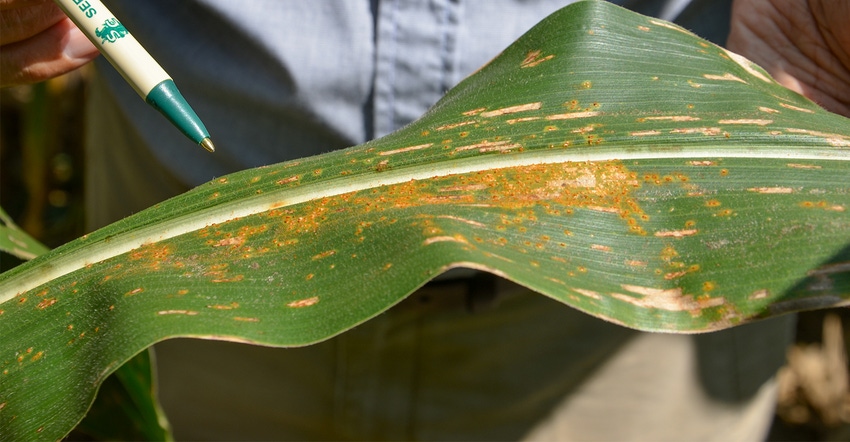
If you didn’t get hit by southern rust in 2016, consider yourself lucky. The fungus which relies on being transported up from the Gulf of Mexico into Indiana each year seldom gets enough of a foothold to cause damage, even if it makes it into the state. However, 2016 was an exception. Agronomists say many cornfields in southern Indiana were hit hard, and the infection came in very late in the season. Can lightning strike twice?
That’s why farmers in south-central Indiana were very aware by July 20 that southern rust had already been found and documented in Kentucky. Their antennae went up even higher when an agronomist found southern rust in a Parke County cornfield, and Purdue University Extension plant pathologists documented that it was southern rust. That happened on July 21.
What could happen yet this year with southern rust, and what can you do about it? Here is information from the agronomist who found rust in Parke County. Matt Mace is with Ceres Solutions, based at the Brazil branch.
Southern rust information
Here are Mace’s answers to Indiana Prairie Farmer’s questions about the disease.
What does southern rust look like in the field? Lesions are smaller, orange or yellowish-orange in color, and it looks like a powder puffball.
How do you tell the difference between southern rust and common rust? Southern rust is only found on the top upper leaf surface. You may find a smaller, circular yellowish outline on the underside of the leaf.
Common rust is larger and reddish to maroon in color. Lesions are rectangular. Lesions that open the cuticle of the leaf look like an open book. This year there has been more common rust in the upper canopy of the corn. This means we’re seeing it on the ear leaf and higher. You may likely find it on one to two leaves above and below the ear leaf.
The overall height of corn this year is a little shorter than normal. That’s not necessarily a bad thing, but this can also leave some leaves a little closer to the ground. That allows for splashing onto leaves. Crowded replant areas make disease transmission that much easier.
Once you find southern rust, should you spray fungicide? Hybrid resistance to southern rust is the cheapest insurance.
Staging corn is most important versus the infestation level. Ear leaf and higher leaves fill corn test weight and provide starch to developing kernels.
Southern rust can develop fast in 80 to 90 degree F temperatures. Later-planted cornfields should be a priority in scouting.
Is it possible to spray fungicide too early? The idea is to spray early, before disease develops and is too far along. Fungicides applied are best used to prevent the disease, and have small windows of effectiveness on already present spores. Fungicides don’t heal already damaged tissues.
Retreatment may be necessary only if a fungicide was applied early, say at silking, and conditions persist 14 to 28 days after application, depending on the product used.
It also depends on hybrid susceptibility, stage of corn and environmental conditions afterward. At the R4 stage, there will still be roughly 34 days to maturity.
Response can be gained [with a later application] but at a decreasing rate as it is made closer to maturity.
How do conditions compare this year vs. last year? Is southern rust likely to be a concern in Indiana again? I can’t speak for everywhere, but central Indiana has had a surplus of rain.
Both common and southern rust must be blown in from Mexico. Southern winds carry the disease up here. Environmental conditions must be right, a susceptible host must be present, and the pathogen must present itself to cause disease development. Take any one of those away, and things slow down or stop.
Always send suspect samples to be confirmed by a university to maintain confidence in our findings. Many eyes are better, because it can take people with various experiences to lead to the correct solution. Sometimes the correct answer is to treat, and other times it’s not.
Is common rust a concern? I believe common rust is what most fields I’ve been in so far have. Usually you find it in the lower canopy below the ear leaf, at a small infestation level of less than 5%. This year, common rust has been higher in the canopy. It’s infected a small band on the leaves and made spores that have fallen into the lower canopy and infected lower leaves, too. In combination with other diseases, this can be a tough one on corn, too. Just think of your corn plant as a factory working at 100% with no disease on the leaves. As different diseases move in, the productivity of the factory diminishes. In some ways, it’s like death by a thousand cuts.
A new tool that I have used this year is the R7 Field Monitoring Tool from WinField United. It compares a grower’s fields to one another to help prioritize where to scout. By using NDVI [Normalized Difference Vegetation Index] aerial images, it helps you decide where to look first. That is always a challenge. This lets you see which fields have more biomass than others, and gives the grower an idea in which way the fields are trending in health, too.
It has been helpful this year in deciding where to spend my time. It doesn’t identify weeds or disease, but can help explain differences between light- and dark-green field biomass. It’s not perfect and is in its infancy stages, but is another tool to use.
About the Author(s)
You May Also Like




